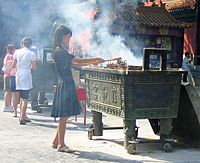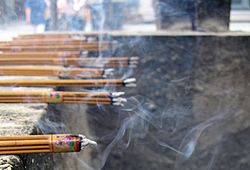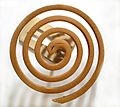Incense facts for kids
Incense is aromatic biotic material which releases fragrant smoke when burned. The term refers to the material itself, rather than to the aroma that it produces. Incense is used for aesthetic reasons, and in therapy, meditation, and ceremony. It may also be used as a simple deodorant or insectifuge.
Incense is composed of aromatic plant materials, often combined with essential oils. Incense can generally be separated into two main types: "indirect-burning" and "direct-burning". Indirect-burning incense (or "non-combustible incense") is not capable of burning on its own, and requires a separate heat source. Direct-burning incense (or "combustible incense") is lit directly by a flame and then fanned or blown out, leaving a glowing ember that smoulders and releases fragrance. Direct-burning incense is either a paste formed around a bamboo stick, or a paste that is molded into a stick or cone shape.
In Judaism, instructions for the use of incense were given in Exodus. (Eg Exodus 30:1). In Christianity, Christ is given myrrh and frankincense by the wise men. (Gospel of Matthew 2:11). The word incense comes from Latin for incendere meaning "to burn".
Incense is also used in Hindu rituals. The Babylonians used incense while offering prayers to divining oracles. Incense spread from there to Greece and Rome.
Contents
Composition
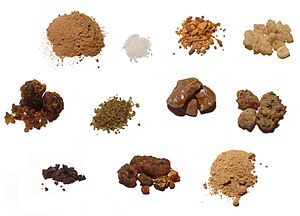
A variety of materials have been used in making incense. Historically there has been a preference for using locally available ingredients. For example, sage and cedar were used by the indigenous peoples of North America. Trading in incense materials comprised a major part of commerce along the Silk Road and other trade routes, one notably called the Incense Route.
Local knowledge and tools were extremely influential on the style, but methods were also influenced by migrations of foreigners, among them clergy and physicians who were both familiar with incense arts.
Production
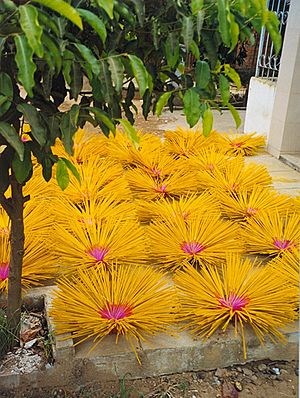
The raw materials are powdered and then mixed together with a binder to form a paste, which, for direct burning incense, are then cut and dried into pellets. Floral fragrances are the most common, but citrus such as lemon is not uncommon. The incense mixture is then rolled out into a slab approximately 1 cm thick and left until the slab has firmed. It is then cut into small cubes, coated with clay powder to prevent adhesion, and allowed to fully harden and dry. In Greece this rolled incense comes in either a pink or green colour denoting the fragrance, with pink being rose and green being jasmine.
Incense mixtures can be extruded or pressed into shapes. Small quantities of water are combined with the fragrance and incense base mixture and kneaded into a hard dough. The incense dough is then pressed into shaped forms to create cone and smaller coiled incense, or forced through a hydraulic press for solid stick incense. The formed incense is then trimmed and slowly dried.
Images for kids
-
A Räucherkerzchen – A charcoal-based incense cone
-
Joss sticks in the Temple of Literature, Hanoi in Hanoi, Vietnam
-
The giant Botafumeiro thurible swinging from the ceiling of the Cathedral of Santiago de Compostela
See also
 In Spanish: Incienso para niños
In Spanish: Incienso para niños


